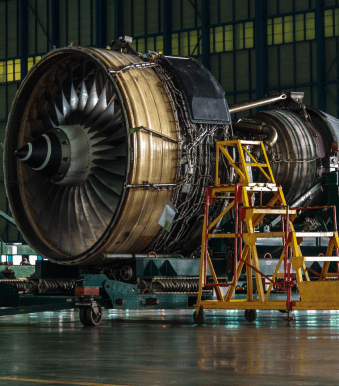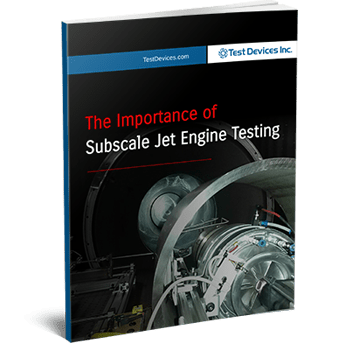The Testing Capabilities of Subscale Jet Engine Rigs – Part 2
High performance machines, such as jet engine and gas turbine parts, need to endure arduous environments for extended periods of time and perform their functions reliably time after time. The parts designed for combustors and turbine systems are subjected to harsh environments resulting from the combined effects of high temperature, combustion gas products and the CF load for rotating parts.
Of course, performing a full-scale engine test would create the most realistic test conditions, but typically these tests can be time consuming to prepare and expensive to perform. It is also an impossible exercise in early stages when the engine and its hardware are still in design and development.

Engineers and scientists working on the development of new materials, coating systems, sensors and part designs for new engine need test data to evaluate and refine their work. Gas burner or torch testing are much more affordable options, but they often fall short of providing the most realistic test conditions.
Fortunately, there is a solution to address and bridge the information gap that currently exists within testing capabilities. Test Devices Inc. provides subscale jet engine testing services to customers who are looking for a more affordable and practical way to gather relevant test data with a high level of realism for materials, coatings, and sensors for new engines in development. Subscale jet engine tests can be readily used to evaluate several essential qualities, including:
- Coating characterization, performance, and durability
- Oxidation and corrosion
- Creep and fatigue
- Fuel burn studies
- Blade high cycle fatigue
- Volcanic ash and CMAS
In this blog, we will discuss the value of subscale testing in coating studies and oxidation and corrosion testing. For a deeper dive into creep and fatigue testing and blade high cycle fatigue testing, be sure to check out the first part of this blog series, The Testing Capabilities of Subscale Jet Engine Rigs – Part 1.
Engine Testing for Challenging Environments
Jet engines are constantly subjected to harsh environments—usually for extended periods of time. Nevertheless, their components must perform consistently and reliably despite these unfavorable conditions.
The blades, vanes and disks of turbomachines often have intricate geometries to optimize aerothermal efficiency. Because such components are routinely subjected to complex mechanical and thermal loading cycles, they can be particularly sensitive to potential damage. The designs of these parts must account for the combined effects of high CF loads, intense heat, and byproducts of gas combustion.
For example, high pressure turbine blades operate above the melting temperature of their base composition metals. Because they are equipped with a precisely designed film air cooling system and a thermo-barrier coating (TBC), the blades can still withstand the extreme temperatures and perform the necessary function without fail.
TBCs, however, can be compromised by oxidation and corrosion, subsequently undermining the performance of the blades themselves. As a result, durable coatings that protect the overall system from damage are essential to a successful jet engine design.
Subscale jet engine tests can be a useful and affordable platform for studying and understanding coating and material degradation when subjected to corrosion and oxidation elements:
- Coating damage studies via surrogate engine use a subscale jet engine as a surrogate test vehicle, modified to accommodate necessary instrumentation. The engine’s turbine blades carry the test coating in question while being introduced to corrosive chemicals for damage observation.
- Coating and air film cooling testing uses the subscale jet engine as a hot gas generator. A plate type test specimen is instrumented with embedded thermocouples (or IR pyrometers) to monitor its operating temperature and then placed in the hot gas stream. Temperature of the exhaust gas and test plate can be controlled independently by an air-cooling system attached to the test plate.
- Aerothermal studies and exhaust gas stream characterization is another process that uses a subscale jet engine as a hot gas generator. The test can be used to economically study the performance of a vane (or nozzle) design by using scaled prototypes manufactured from 3D printers. The use of a robotic sensor probe accurately captures the flow temperature and pressure at defined coordinates in the hot exhaust gas stream and maps the data in a 3D space to validate a CFD model and update the design.
With subscale jet engine rigs, engineers and designers can test and study the performance of newly designed parts in more realistic test conditions, reducing the risk of “surprises” and contributing to the confidence of a successful launch and the operation of new products.
Small Turbine Rig Testing with Test Devices, Inc.
A small turbine test rig offers a viable alternative to pre-existing test methods, including superior test realism and several other attractive advantages:
- Affordable: Testing on a small turbine test rig is much less expensive to perform when compared with a full-scale engine test.
- Efficient: The ability to complete test projects in a few months rather than years
- Flexible: It is easy to change test parameters, including adding/removing sensors and instrumentations, varying the engine or test hardware configurations.
At TDI, we rely on our extensive experience with subscale jet engine testing to develop dependable test solutions to even the most challenging mechanical needs. To learn more about small rig and subscale jet engine testing with our team, download our eBook, The Importance of Subscale Jet Engine Testing or reach out to request a quote today.




